Inclusive Practice for Nursing: Understanding Marginalized Groups
VerifiedAdded on 2020/03/16
|8
|2091
|57
Report
AI Summary
This report delves into inclusive practices within the nursing field, specifically examining the challenges and experiences of two marginalized groups: wheelchair users and transgender individuals within the Australian community. The report investigates the impact of stigma on their health, exploring issues such as employment discrimination, wage gaps, and health disparities. It also discusses social inclusion and human rights, outlining policies that can promote inclusivity, such as creating employment opportunities, increasing representation in political settings, and implementing early intervention programs. The report highlights the importance of a strength-based approach, giving priority to early intervention, and planning for sustainability to address the long-term needs of these communities. By analyzing the effects of discrimination and proposing strategies for promoting equality and understanding, this report aims to contribute to a more inclusive and equitable healthcare system for all.
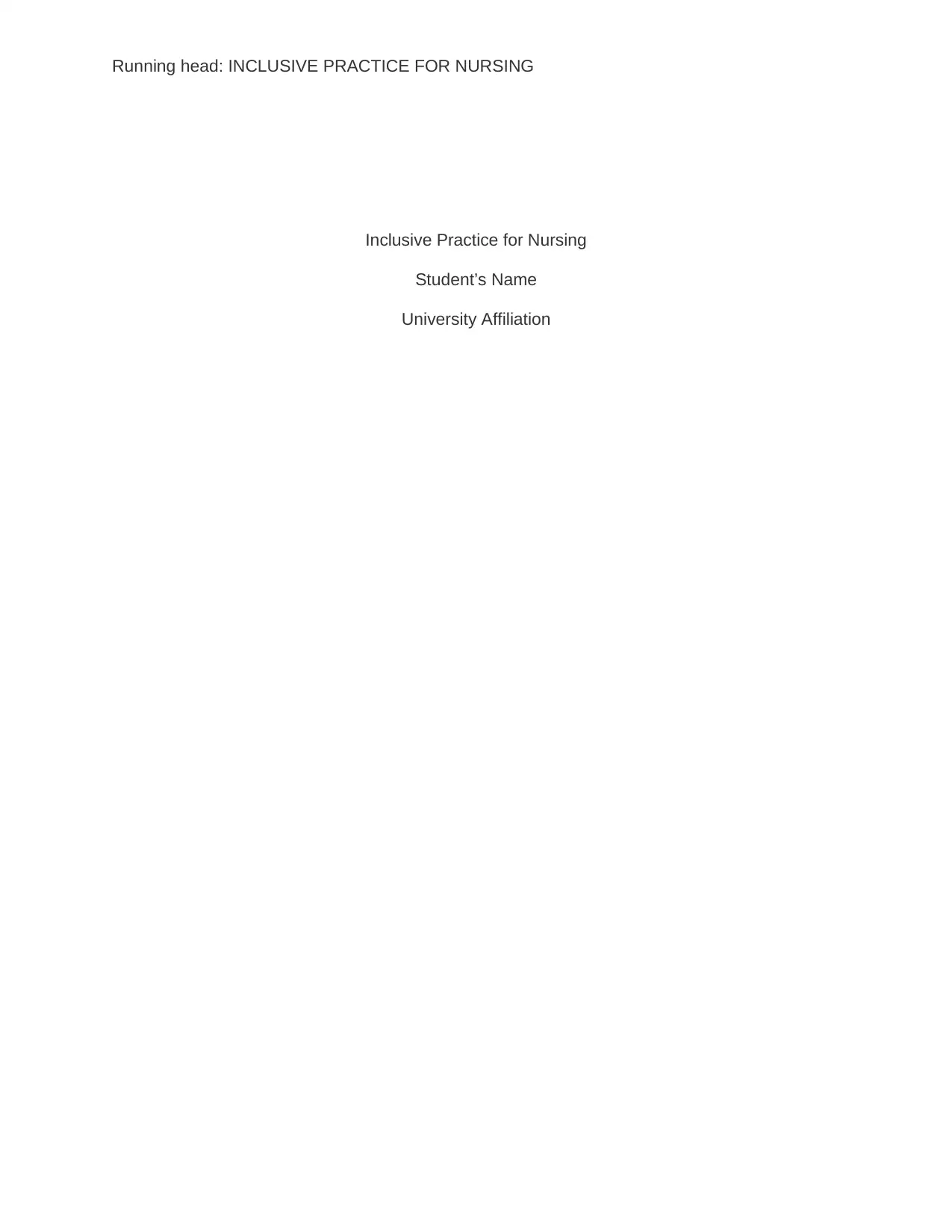
Running head: INCLUSIVE PRACTICE FOR NURSING
Inclusive Practice for Nursing
Student’s Name
University Affiliation
Inclusive Practice for Nursing
Student’s Name
University Affiliation
Paraphrase This Document
Need a fresh take? Get an instant paraphrase of this document with our AI Paraphraser
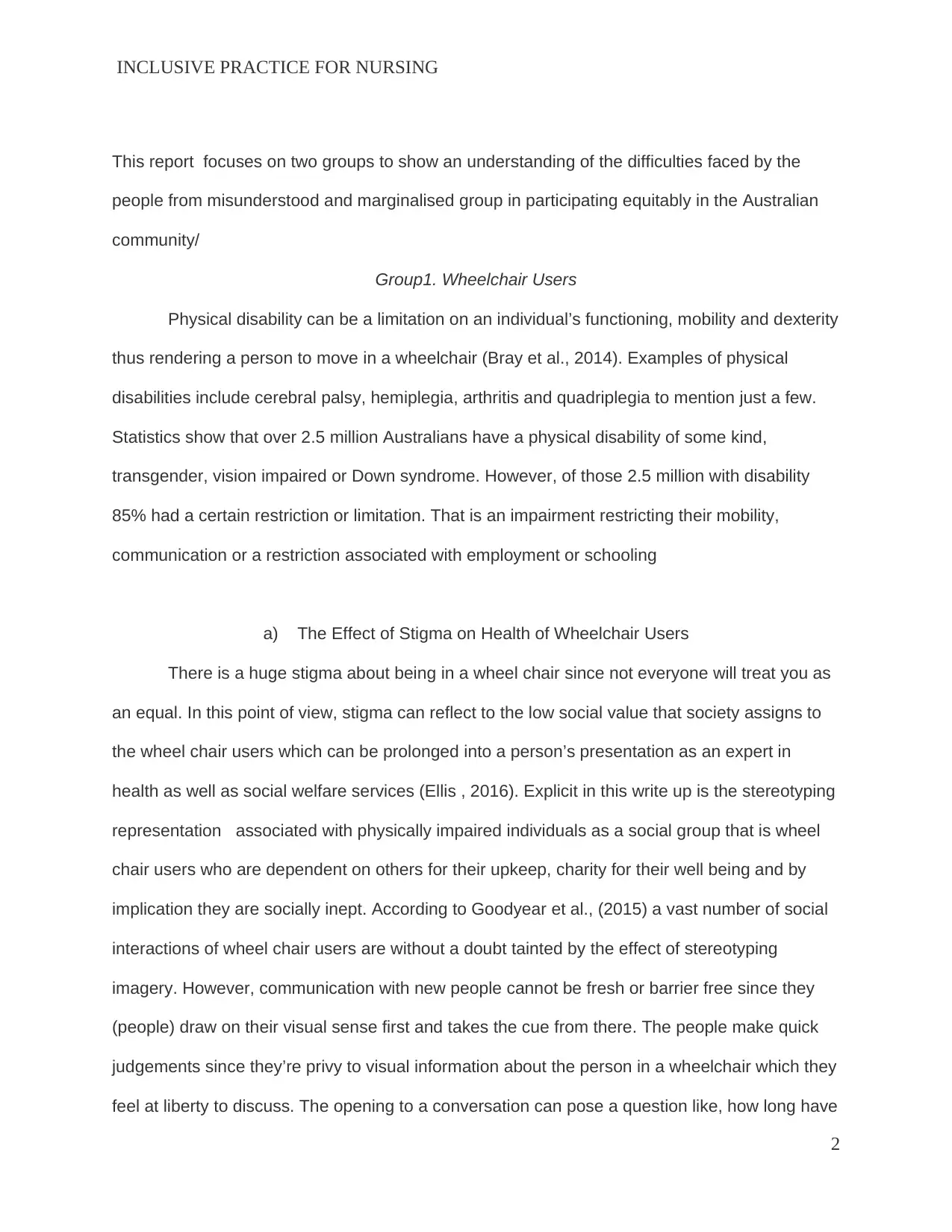
INCLUSIVE PRACTICE FOR NURSING
This report focuses on two groups to show an understanding of the difficulties faced by the
people from misunderstood and marginalised group in participating equitably in the Australian
community/
Group1. Wheelchair Users
Physical disability can be a limitation on an individual’s functioning, mobility and dexterity
thus rendering a person to move in a wheelchair (Bray et al., 2014). Examples of physical
disabilities include cerebral palsy, hemiplegia, arthritis and quadriplegia to mention just a few.
Statistics show that over 2.5 million Australians have a physical disability of some kind,
transgender, vision impaired or Down syndrome. However, of those 2.5 million with disability
85% had a certain restriction or limitation. That is an impairment restricting their mobility,
communication or a restriction associated with employment or schooling
a) The Effect of Stigma on Health of Wheelchair Users
There is a huge stigma about being in a wheel chair since not everyone will treat you as
an equal. In this point of view, stigma can reflect to the low social value that society assigns to
the wheel chair users which can be prolonged into a person’s presentation as an expert in
health as well as social welfare services (Ellis , 2016). Explicit in this write up is the stereotyping
representation associated with physically impaired individuals as a social group that is wheel
chair users who are dependent on others for their upkeep, charity for their well being and by
implication they are socially inept. According to Goodyear et al., (2015) a vast number of social
interactions of wheel chair users are without a doubt tainted by the effect of stereotyping
imagery. However, communication with new people cannot be fresh or barrier free since they
(people) draw on their visual sense first and takes the cue from there. The people make quick
judgements since they’re privy to visual information about the person in a wheelchair which they
feel at liberty to discuss. The opening to a conversation can pose a question like, how long have
2
This report focuses on two groups to show an understanding of the difficulties faced by the
people from misunderstood and marginalised group in participating equitably in the Australian
community/
Group1. Wheelchair Users
Physical disability can be a limitation on an individual’s functioning, mobility and dexterity
thus rendering a person to move in a wheelchair (Bray et al., 2014). Examples of physical
disabilities include cerebral palsy, hemiplegia, arthritis and quadriplegia to mention just a few.
Statistics show that over 2.5 million Australians have a physical disability of some kind,
transgender, vision impaired or Down syndrome. However, of those 2.5 million with disability
85% had a certain restriction or limitation. That is an impairment restricting their mobility,
communication or a restriction associated with employment or schooling
a) The Effect of Stigma on Health of Wheelchair Users
There is a huge stigma about being in a wheel chair since not everyone will treat you as
an equal. In this point of view, stigma can reflect to the low social value that society assigns to
the wheel chair users which can be prolonged into a person’s presentation as an expert in
health as well as social welfare services (Ellis , 2016). Explicit in this write up is the stereotyping
representation associated with physically impaired individuals as a social group that is wheel
chair users who are dependent on others for their upkeep, charity for their well being and by
implication they are socially inept. According to Goodyear et al., (2015) a vast number of social
interactions of wheel chair users are without a doubt tainted by the effect of stereotyping
imagery. However, communication with new people cannot be fresh or barrier free since they
(people) draw on their visual sense first and takes the cue from there. The people make quick
judgements since they’re privy to visual information about the person in a wheelchair which they
feel at liberty to discuss. The opening to a conversation can pose a question like, how long have
2
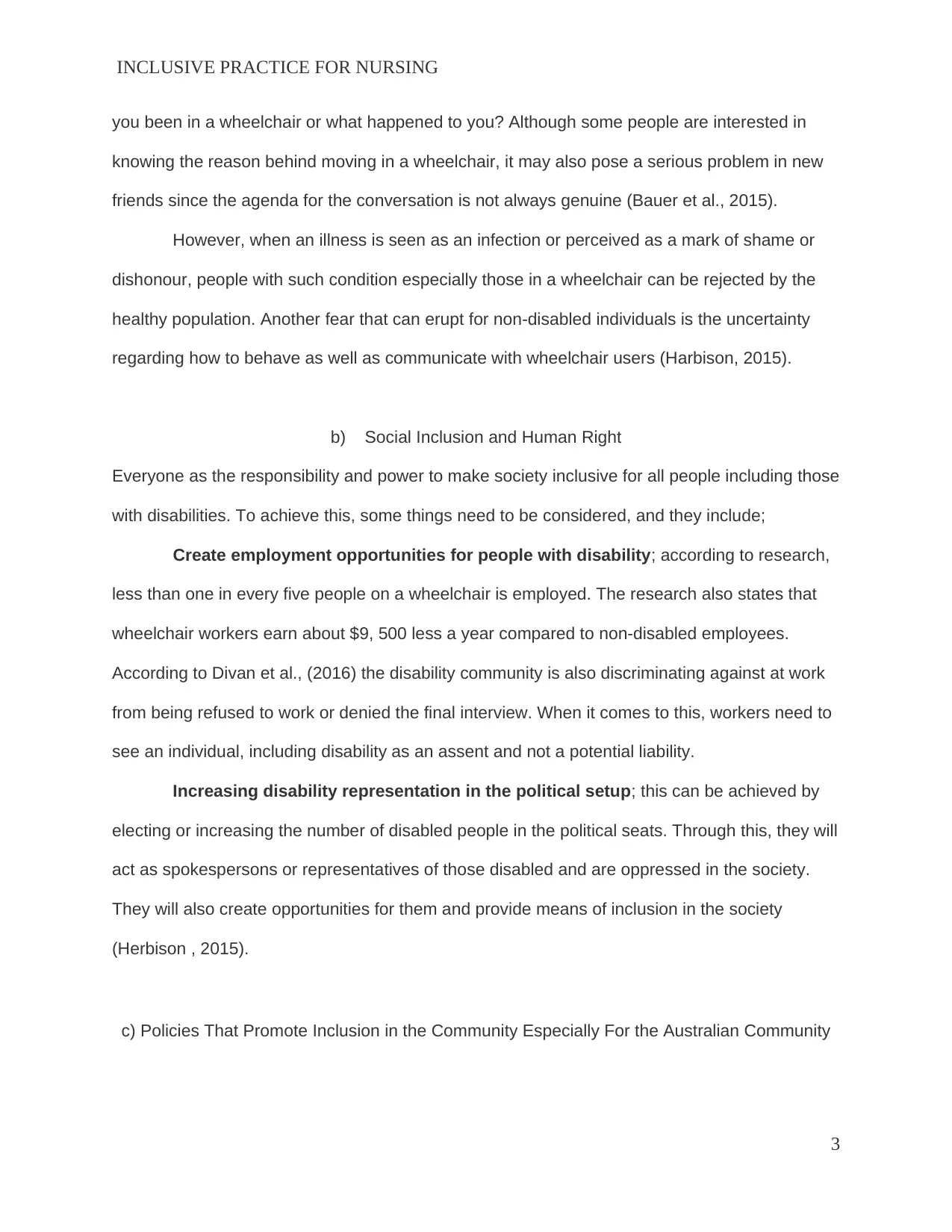
INCLUSIVE PRACTICE FOR NURSING
you been in a wheelchair or what happened to you? Although some people are interested in
knowing the reason behind moving in a wheelchair, it may also pose a serious problem in new
friends since the agenda for the conversation is not always genuine (Bauer et al., 2015).
However, when an illness is seen as an infection or perceived as a mark of shame or
dishonour, people with such condition especially those in a wheelchair can be rejected by the
healthy population. Another fear that can erupt for non-disabled individuals is the uncertainty
regarding how to behave as well as communicate with wheelchair users (Harbison, 2015).
b) Social Inclusion and Human Right
Everyone as the responsibility and power to make society inclusive for all people including those
with disabilities. To achieve this, some things need to be considered, and they include;
Create employment opportunities for people with disability; according to research,
less than one in every five people on a wheelchair is employed. The research also states that
wheelchair workers earn about $9, 500 less a year compared to non-disabled employees.
According to Divan et al., (2016) the disability community is also discriminating against at work
from being refused to work or denied the final interview. When it comes to this, workers need to
see an individual, including disability as an assent and not a potential liability.
Increasing disability representation in the political setup; this can be achieved by
electing or increasing the number of disabled people in the political seats. Through this, they will
act as spokespersons or representatives of those disabled and are oppressed in the society.
They will also create opportunities for them and provide means of inclusion in the society
(Herbison , 2015).
c) Policies That Promote Inclusion in the Community Especially For the Australian Community
3
you been in a wheelchair or what happened to you? Although some people are interested in
knowing the reason behind moving in a wheelchair, it may also pose a serious problem in new
friends since the agenda for the conversation is not always genuine (Bauer et al., 2015).
However, when an illness is seen as an infection or perceived as a mark of shame or
dishonour, people with such condition especially those in a wheelchair can be rejected by the
healthy population. Another fear that can erupt for non-disabled individuals is the uncertainty
regarding how to behave as well as communicate with wheelchair users (Harbison, 2015).
b) Social Inclusion and Human Right
Everyone as the responsibility and power to make society inclusive for all people including those
with disabilities. To achieve this, some things need to be considered, and they include;
Create employment opportunities for people with disability; according to research,
less than one in every five people on a wheelchair is employed. The research also states that
wheelchair workers earn about $9, 500 less a year compared to non-disabled employees.
According to Divan et al., (2016) the disability community is also discriminating against at work
from being refused to work or denied the final interview. When it comes to this, workers need to
see an individual, including disability as an assent and not a potential liability.
Increasing disability representation in the political setup; this can be achieved by
electing or increasing the number of disabled people in the political seats. Through this, they will
act as spokespersons or representatives of those disabled and are oppressed in the society.
They will also create opportunities for them and provide means of inclusion in the society
(Herbison , 2015).
c) Policies That Promote Inclusion in the Community Especially For the Australian Community
3
⊘ This is a preview!⊘
Do you want full access?
Subscribe today to unlock all pages.

Trusted by 1+ million students worldwide
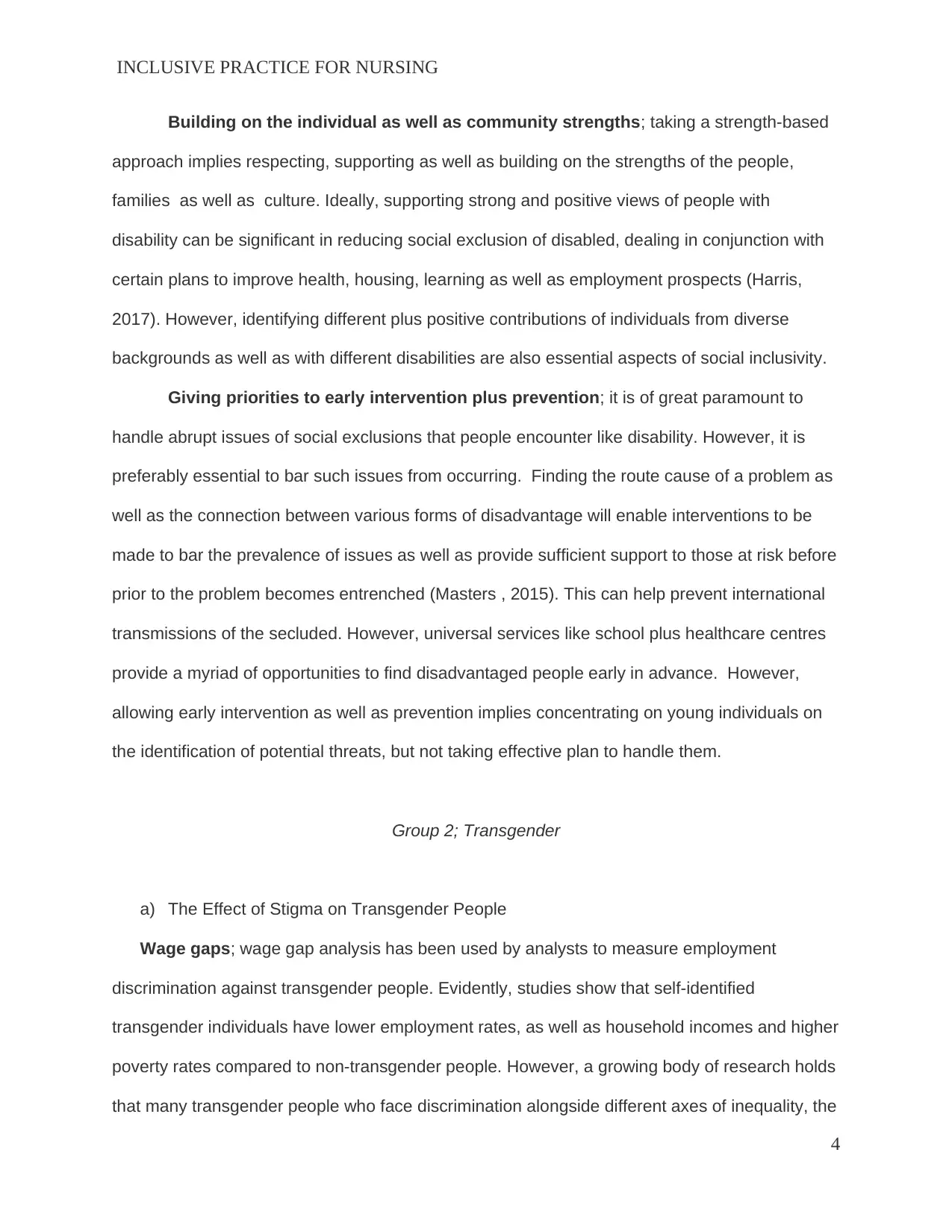
INCLUSIVE PRACTICE FOR NURSING
Building on the individual as well as community strengths; taking a strength-based
approach implies respecting, supporting as well as building on the strengths of the people,
families as well as culture. Ideally, supporting strong and positive views of people with
disability can be significant in reducing social exclusion of disabled, dealing in conjunction with
certain plans to improve health, housing, learning as well as employment prospects (Harris,
2017). However, identifying different plus positive contributions of individuals from diverse
backgrounds as well as with different disabilities are also essential aspects of social inclusivity.
Giving priorities to early intervention plus prevention; it is of great paramount to
handle abrupt issues of social exclusions that people encounter like disability. However, it is
preferably essential to bar such issues from occurring. Finding the route cause of a problem as
well as the connection between various forms of disadvantage will enable interventions to be
made to bar the prevalence of issues as well as provide sufficient support to those at risk before
prior to the problem becomes entrenched (Masters , 2015). This can help prevent international
transmissions of the secluded. However, universal services like school plus healthcare centres
provide a myriad of opportunities to find disadvantaged people early in advance. However,
allowing early intervention as well as prevention implies concentrating on young individuals on
the identification of potential threats, but not taking effective plan to handle them.
Group 2; Transgender
a) The Effect of Stigma on Transgender People
Wage gaps; wage gap analysis has been used by analysts to measure employment
discrimination against transgender people. Evidently, studies show that self-identified
transgender individuals have lower employment rates, as well as household incomes and higher
poverty rates compared to non-transgender people. However, a growing body of research holds
that many transgender people who face discrimination alongside different axes of inequality, the
4
Building on the individual as well as community strengths; taking a strength-based
approach implies respecting, supporting as well as building on the strengths of the people,
families as well as culture. Ideally, supporting strong and positive views of people with
disability can be significant in reducing social exclusion of disabled, dealing in conjunction with
certain plans to improve health, housing, learning as well as employment prospects (Harris,
2017). However, identifying different plus positive contributions of individuals from diverse
backgrounds as well as with different disabilities are also essential aspects of social inclusivity.
Giving priorities to early intervention plus prevention; it is of great paramount to
handle abrupt issues of social exclusions that people encounter like disability. However, it is
preferably essential to bar such issues from occurring. Finding the route cause of a problem as
well as the connection between various forms of disadvantage will enable interventions to be
made to bar the prevalence of issues as well as provide sufficient support to those at risk before
prior to the problem becomes entrenched (Masters , 2015). This can help prevent international
transmissions of the secluded. However, universal services like school plus healthcare centres
provide a myriad of opportunities to find disadvantaged people early in advance. However,
allowing early intervention as well as prevention implies concentrating on young individuals on
the identification of potential threats, but not taking effective plan to handle them.
Group 2; Transgender
a) The Effect of Stigma on Transgender People
Wage gaps; wage gap analysis has been used by analysts to measure employment
discrimination against transgender people. Evidently, studies show that self-identified
transgender individuals have lower employment rates, as well as household incomes and higher
poverty rates compared to non-transgender people. However, a growing body of research holds
that many transgender people who face discrimination alongside different axes of inequality, the
4
Paraphrase This Document
Need a fresh take? Get an instant paraphrase of this document with our AI Paraphraser
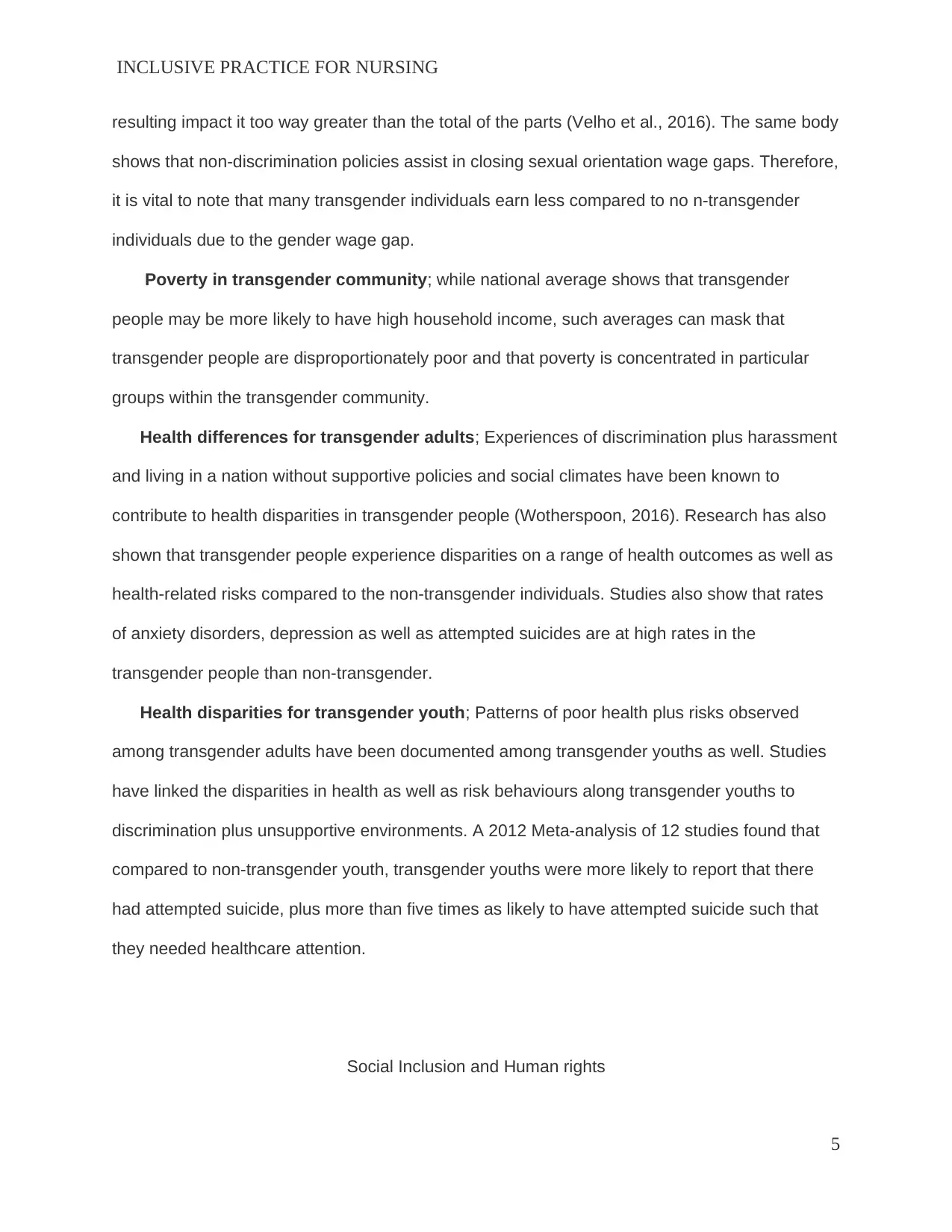
INCLUSIVE PRACTICE FOR NURSING
resulting impact it too way greater than the total of the parts (Velho et al., 2016). The same body
shows that non-discrimination policies assist in closing sexual orientation wage gaps. Therefore,
it is vital to note that many transgender individuals earn less compared to no n-transgender
individuals due to the gender wage gap.
Poverty in transgender community; while national average shows that transgender
people may be more likely to have high household income, such averages can mask that
transgender people are disproportionately poor and that poverty is concentrated in particular
groups within the transgender community.
Health differences for transgender adults; Experiences of discrimination plus harassment
and living in a nation without supportive policies and social climates have been known to
contribute to health disparities in transgender people (Wotherspoon, 2016). Research has also
shown that transgender people experience disparities on a range of health outcomes as well as
health-related risks compared to the non-transgender individuals. Studies also show that rates
of anxiety disorders, depression as well as attempted suicides are at high rates in the
transgender people than non-transgender.
Health disparities for transgender youth; Patterns of poor health plus risks observed
among transgender adults have been documented among transgender youths as well. Studies
have linked the disparities in health as well as risk behaviours along transgender youths to
discrimination plus unsupportive environments. A 2012 Meta-analysis of 12 studies found that
compared to non-transgender youth, transgender youths were more likely to report that there
had attempted suicide, plus more than five times as likely to have attempted suicide such that
they needed healthcare attention.
Social Inclusion and Human rights
5
resulting impact it too way greater than the total of the parts (Velho et al., 2016). The same body
shows that non-discrimination policies assist in closing sexual orientation wage gaps. Therefore,
it is vital to note that many transgender individuals earn less compared to no n-transgender
individuals due to the gender wage gap.
Poverty in transgender community; while national average shows that transgender
people may be more likely to have high household income, such averages can mask that
transgender people are disproportionately poor and that poverty is concentrated in particular
groups within the transgender community.
Health differences for transgender adults; Experiences of discrimination plus harassment
and living in a nation without supportive policies and social climates have been known to
contribute to health disparities in transgender people (Wotherspoon, 2016). Research has also
shown that transgender people experience disparities on a range of health outcomes as well as
health-related risks compared to the non-transgender individuals. Studies also show that rates
of anxiety disorders, depression as well as attempted suicides are at high rates in the
transgender people than non-transgender.
Health disparities for transgender youth; Patterns of poor health plus risks observed
among transgender adults have been documented among transgender youths as well. Studies
have linked the disparities in health as well as risk behaviours along transgender youths to
discrimination plus unsupportive environments. A 2012 Meta-analysis of 12 studies found that
compared to non-transgender youth, transgender youths were more likely to report that there
had attempted suicide, plus more than five times as likely to have attempted suicide such that
they needed healthcare attention.
Social Inclusion and Human rights
5
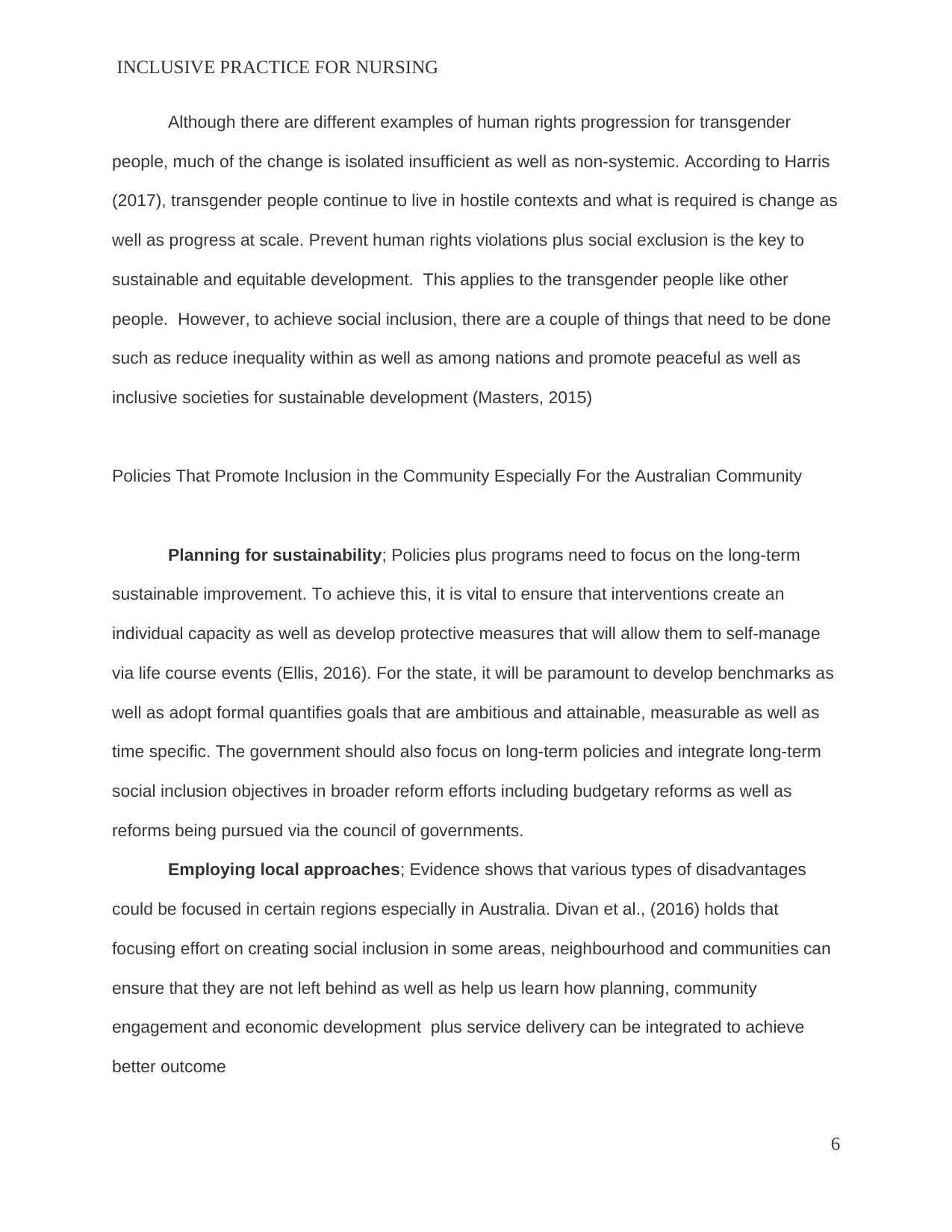
INCLUSIVE PRACTICE FOR NURSING
Although there are different examples of human rights progression for transgender
people, much of the change is isolated insufficient as well as non-systemic. According to Harris
(2017), transgender people continue to live in hostile contexts and what is required is change as
well as progress at scale. Prevent human rights violations plus social exclusion is the key to
sustainable and equitable development. This applies to the transgender people like other
people. However, to achieve social inclusion, there are a couple of things that need to be done
such as reduce inequality within as well as among nations and promote peaceful as well as
inclusive societies for sustainable development (Masters, 2015)
Policies That Promote Inclusion in the Community Especially For the Australian Community
Planning for sustainability; Policies plus programs need to focus on the long-term
sustainable improvement. To achieve this, it is vital to ensure that interventions create an
individual capacity as well as develop protective measures that will allow them to self-manage
via life course events (Ellis, 2016). For the state, it will be paramount to develop benchmarks as
well as adopt formal quantifies goals that are ambitious and attainable, measurable as well as
time specific. The government should also focus on long-term policies and integrate long-term
social inclusion objectives in broader reform efforts including budgetary reforms as well as
reforms being pursued via the council of governments.
Employing local approaches; Evidence shows that various types of disadvantages
could be focused in certain regions especially in Australia. Divan et al., (2016) holds that
focusing effort on creating social inclusion in some areas, neighbourhood and communities can
ensure that they are not left behind as well as help us learn how planning, community
engagement and economic development plus service delivery can be integrated to achieve
better outcome
6
Although there are different examples of human rights progression for transgender
people, much of the change is isolated insufficient as well as non-systemic. According to Harris
(2017), transgender people continue to live in hostile contexts and what is required is change as
well as progress at scale. Prevent human rights violations plus social exclusion is the key to
sustainable and equitable development. This applies to the transgender people like other
people. However, to achieve social inclusion, there are a couple of things that need to be done
such as reduce inequality within as well as among nations and promote peaceful as well as
inclusive societies for sustainable development (Masters, 2015)
Policies That Promote Inclusion in the Community Especially For the Australian Community
Planning for sustainability; Policies plus programs need to focus on the long-term
sustainable improvement. To achieve this, it is vital to ensure that interventions create an
individual capacity as well as develop protective measures that will allow them to self-manage
via life course events (Ellis, 2016). For the state, it will be paramount to develop benchmarks as
well as adopt formal quantifies goals that are ambitious and attainable, measurable as well as
time specific. The government should also focus on long-term policies and integrate long-term
social inclusion objectives in broader reform efforts including budgetary reforms as well as
reforms being pursued via the council of governments.
Employing local approaches; Evidence shows that various types of disadvantages
could be focused in certain regions especially in Australia. Divan et al., (2016) holds that
focusing effort on creating social inclusion in some areas, neighbourhood and communities can
ensure that they are not left behind as well as help us learn how planning, community
engagement and economic development plus service delivery can be integrated to achieve
better outcome
6
⊘ This is a preview!⊘
Do you want full access?
Subscribe today to unlock all pages.

Trusted by 1+ million students worldwide
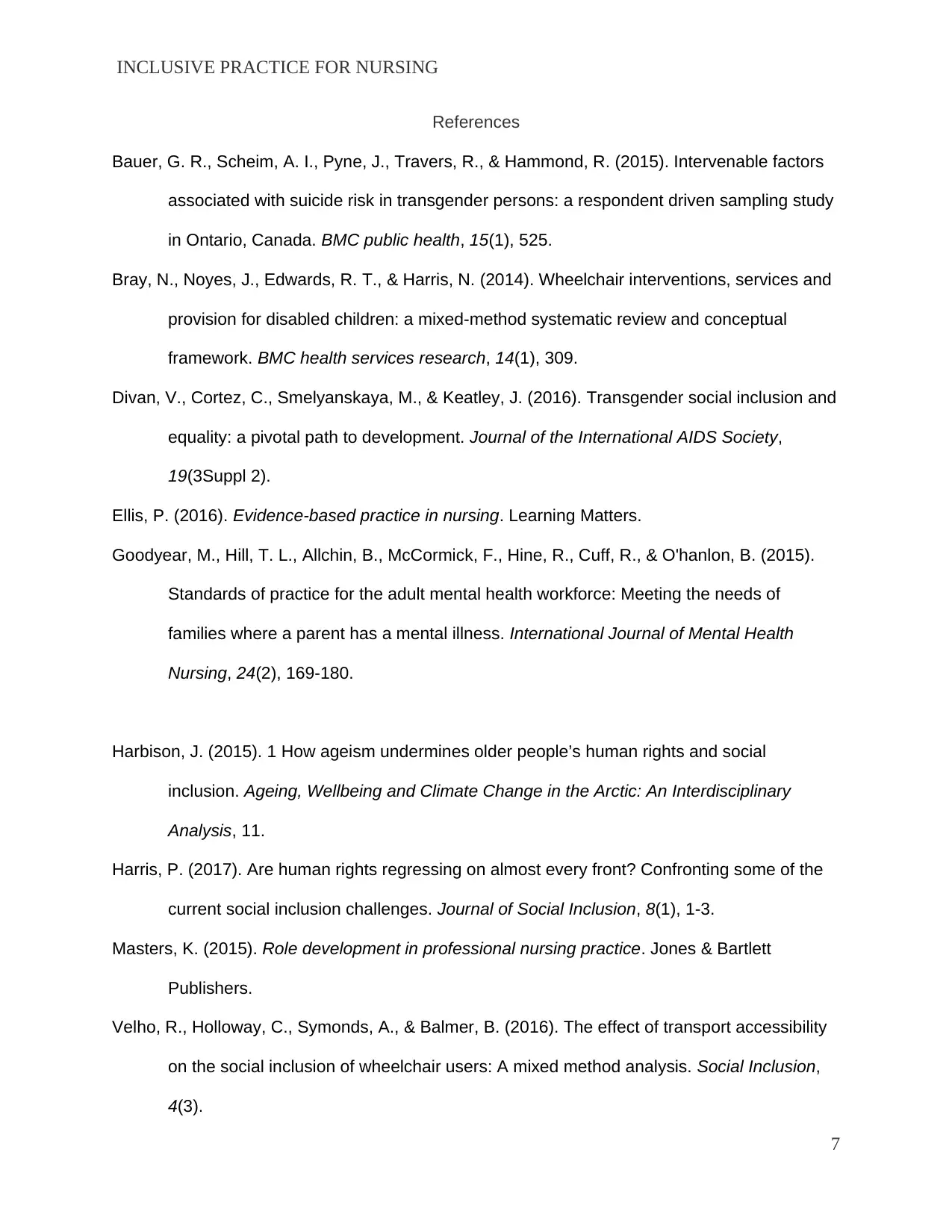
INCLUSIVE PRACTICE FOR NURSING
References
Bauer, G. R., Scheim, A. I., Pyne, J., Travers, R., & Hammond, R. (2015). Intervenable factors
associated with suicide risk in transgender persons: a respondent driven sampling study
in Ontario, Canada. BMC public health, 15(1), 525.
Bray, N., Noyes, J., Edwards, R. T., & Harris, N. (2014). Wheelchair interventions, services and
provision for disabled children: a mixed-method systematic review and conceptual
framework. BMC health services research, 14(1), 309.
Divan, V., Cortez, C., Smelyanskaya, M., & Keatley, J. (2016). Transgender social inclusion and
equality: a pivotal path to development. Journal of the International AIDS Society,
19(3Suppl 2).
Ellis, P. (2016). Evidence-based practice in nursing. Learning Matters.
Goodyear, M., Hill, T. L., Allchin, B., McCormick, F., Hine, R., Cuff, R., & O'hanlon, B. (2015).
Standards of practice for the adult mental health workforce: Meeting the needs of
families where a parent has a mental illness. International Journal of Mental Health
Nursing, 24(2), 169-180.
Harbison, J. (2015). 1 How ageism undermines older people’s human rights and social
inclusion. Ageing, Wellbeing and Climate Change in the Arctic: An Interdisciplinary
Analysis, 11.
Harris, P. (2017). Are human rights regressing on almost every front? Confronting some of the
current social inclusion challenges. Journal of Social Inclusion, 8(1), 1-3.
Masters, K. (2015). Role development in professional nursing practice. Jones & Bartlett
Publishers.
Velho, R., Holloway, C., Symonds, A., & Balmer, B. (2016). The effect of transport accessibility
on the social inclusion of wheelchair users: A mixed method analysis. Social Inclusion,
4(3).
7
References
Bauer, G. R., Scheim, A. I., Pyne, J., Travers, R., & Hammond, R. (2015). Intervenable factors
associated with suicide risk in transgender persons: a respondent driven sampling study
in Ontario, Canada. BMC public health, 15(1), 525.
Bray, N., Noyes, J., Edwards, R. T., & Harris, N. (2014). Wheelchair interventions, services and
provision for disabled children: a mixed-method systematic review and conceptual
framework. BMC health services research, 14(1), 309.
Divan, V., Cortez, C., Smelyanskaya, M., & Keatley, J. (2016). Transgender social inclusion and
equality: a pivotal path to development. Journal of the International AIDS Society,
19(3Suppl 2).
Ellis, P. (2016). Evidence-based practice in nursing. Learning Matters.
Goodyear, M., Hill, T. L., Allchin, B., McCormick, F., Hine, R., Cuff, R., & O'hanlon, B. (2015).
Standards of practice for the adult mental health workforce: Meeting the needs of
families where a parent has a mental illness. International Journal of Mental Health
Nursing, 24(2), 169-180.
Harbison, J. (2015). 1 How ageism undermines older people’s human rights and social
inclusion. Ageing, Wellbeing and Climate Change in the Arctic: An Interdisciplinary
Analysis, 11.
Harris, P. (2017). Are human rights regressing on almost every front? Confronting some of the
current social inclusion challenges. Journal of Social Inclusion, 8(1), 1-3.
Masters, K. (2015). Role development in professional nursing practice. Jones & Bartlett
Publishers.
Velho, R., Holloway, C., Symonds, A., & Balmer, B. (2016). The effect of transport accessibility
on the social inclusion of wheelchair users: A mixed method analysis. Social Inclusion,
4(3).
7
Paraphrase This Document
Need a fresh take? Get an instant paraphrase of this document with our AI Paraphraser
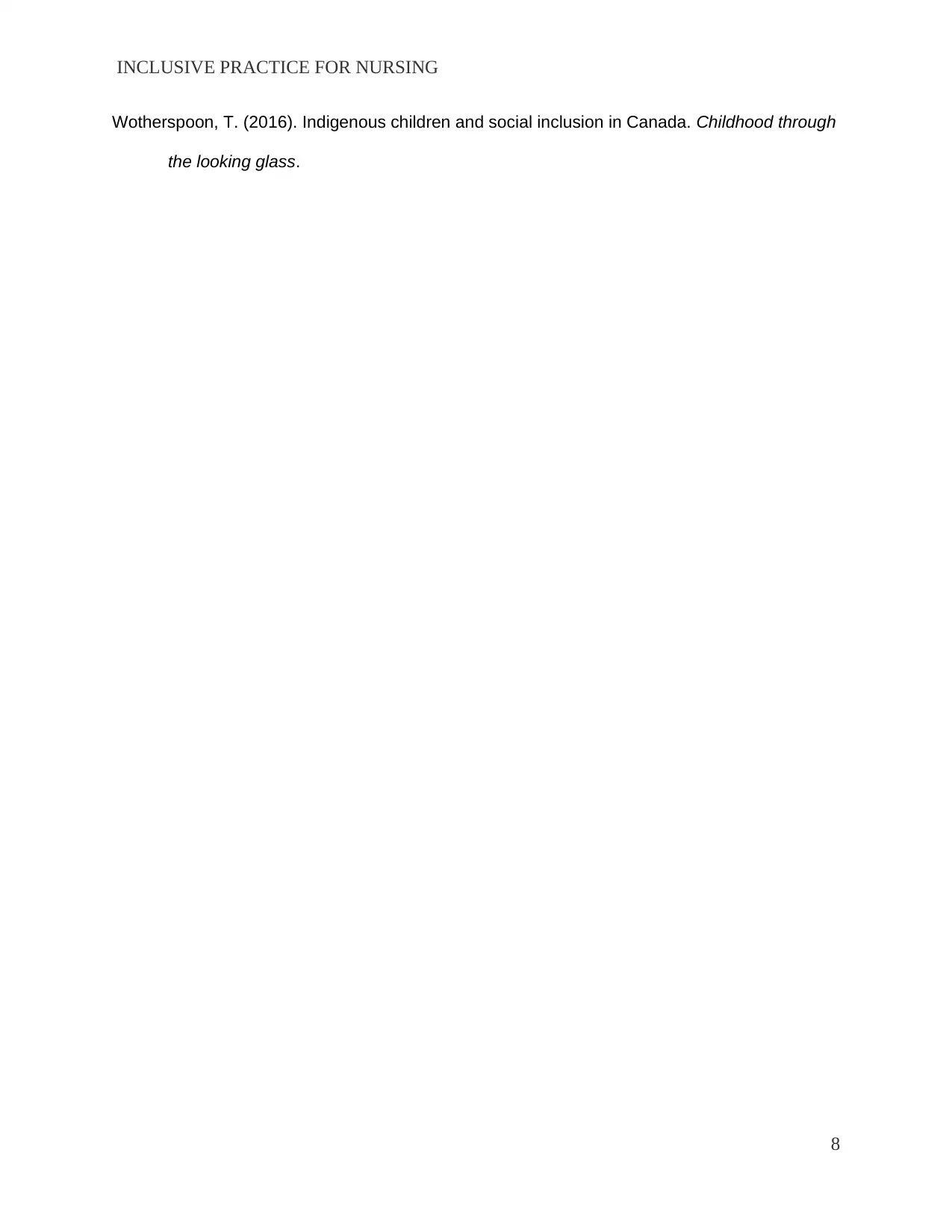
INCLUSIVE PRACTICE FOR NURSING
Wotherspoon, T. (2016). Indigenous children and social inclusion in Canada. Childhood through
the looking glass.
8
Wotherspoon, T. (2016). Indigenous children and social inclusion in Canada. Childhood through
the looking glass.
8
1 out of 8
Related Documents
Your All-in-One AI-Powered Toolkit for Academic Success.
+13062052269
info@desklib.com
Available 24*7 on WhatsApp / Email
![[object Object]](/_next/static/media/star-bottom.7253800d.svg)
Unlock your academic potential
Copyright © 2020–2025 A2Z Services. All Rights Reserved. Developed and managed by ZUCOL.





